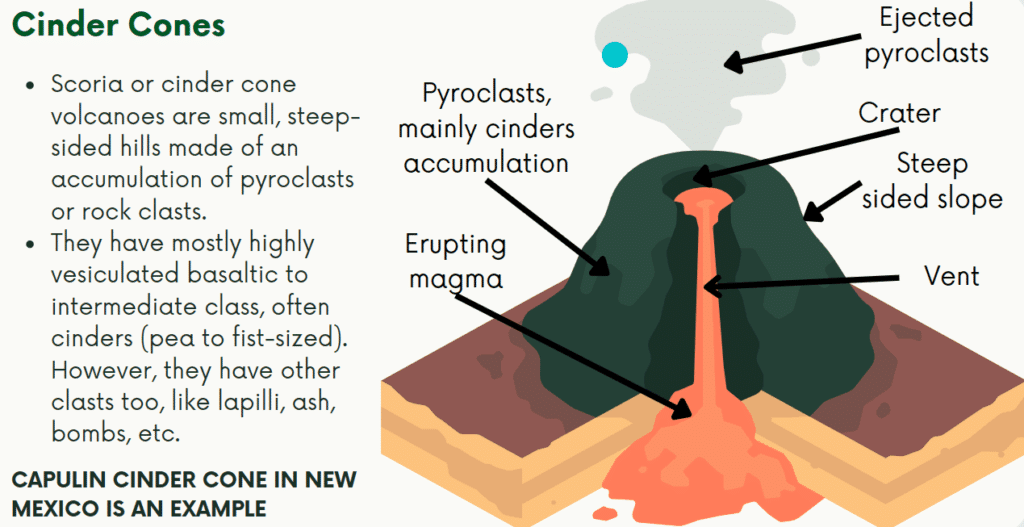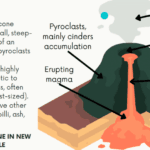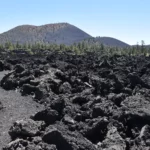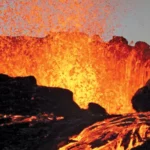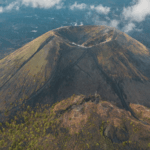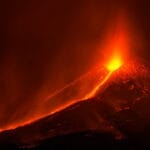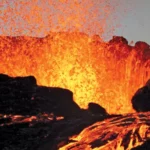Arizona might not be as famous for volcanoes as, say, Hawaii, but it boasts a captivating volcanic history and even a few areas where eruptions could potentially occur. Let’s delve into the fiery past and present of Arizona’s volcanoes to uncover the secrets hidden beneath the surface.
How Many Active Volcanoes Are in Arizona?
While you won’t encounter flowing lava on your next desert hike, the idea of volcanic activity in Arizona isn’t as far-fetched as you might think. “Active,” in geological terms, doesn’t necessarily mean constant eruptions. An active volcano is one that has erupted in the past 10,000 years and could erupt again.
Arizona is home to three primary volcanic fields that geologists monitor:
- The San Francisco Volcanic Field: This expansive field, spanning 3,000 square miles, is a testament to Arizona’s volcanic past, containing over 600 volcanoes.
- The Uinkaret Volcanic Field: Characterized by dramatic landscapes shaped by past eruptions, the Uinkaret Volcanic Field is smaller than the San Francisco field but no less captivating.
- The Pinacate Volcanic Field: Here, you’ll find striking black lava flows and cinder cones that stand in stark contrast to the surrounding desert.
These three active fields, along with four others classified as extinct (meaning they are unlikely to erupt again), make Arizona a fascinating destination for anyone interested in the Earth’s fiery nature. While predicting volcanic eruptions with absolute certainty remains a challenge, one thing is certain – Arizona’s volcanic past has left an indelible mark on the state’s landscape, creating a unique and captivating environment.
When was the last volcano eruption in Arizona?
The most recent eruption in Arizona occurred in the San Francisco volcanic field, which is still considered active today. Around 1085 CE, a cinder cone eruption created the now-iconic Sunset Crater. Its vibrant red and orange slopes offer a stunning reminder of Arizona’s explosive past.
However, the absence of recent eruptions doesn’t mean Arizona’s volcanoes are dormant. Along with the San Francisco field, the Uinkaret and Pinacate fields are considered active, suggesting the potential for future eruptions.
Consider This:
- Imagine living in Arizona in 1085 CE, witnessing the ground shake and a massive ash plume fill the sky as Sunset Crater erupted.
- Although Arizona’s volcanoes are quiet now, they underscore the Earth’s constant state of change and the forces that have shaped our planet for millennia.
Arizona’s volcanic story is far from over.
Are there any supervolcanoes in Arizona?
While Arizona boasts an impressive volcanic history with seven active volcanic fields, it lacks the supervolcanoes capable of continent-reshaping eruptions. Arizona’s volcanoes are primarily ‘basaltic,’ meaning their eruptions are more localized and less explosive, typically characterized by flowing lava and cinder cones rather than massive, ash-filled explosions.
Although Arizona’s volcanoes have undoubtedly left their mark on the landscape, creating dramatic lava flows and rugged features, they are not considered a major threat. Scientists continuously monitor volcanic activity and currently assess the risk posed by Arizona’s volcanic fields to surrounding communities as low.
What is the largest volcano in Arizona?
Determining the absolute largest volcano in Arizona depends on how “largest” is defined – by height or area covered. If we consider sheer size and area, the San Francisco Volcanic Field takes the crown, sprawling over 3,000 square miles and containing over 600 volcanoes, ranging from classic cone-shaped formations to vast, hardened lava flows.
While Arizona has no currently erupting volcanoes, the San Francisco Volcanic Field, along with the Uinkaret and Pinacate Fields, are considered active because of their potential for future eruptions.
While pinpointing a single “largest” volcano in Arizona is challenging, the San Francisco Volcanic Field stands out as the most impressive and potentially active volcanic area in the state.
Are there inactive volcanoes in Arizona?
Absolutely! Arizona’s landscape is dotted with over 1,000 extinct volcanoes, remnants of a fiery past. These dormant giants, no longer spewing lava, contribute significantly to Arizona’s unique scenery.
While the San Francisco, Uinkaret, and Pinacate volcanic fields remain active, the numerous extinct volcanoes serve as a reminder of the dynamic forces that have shaped the region over millions of years. Scientists continue to study these inactive volcanoes to gain a deeper understanding of Earth’s geological processes.
What year did the Yellowstone volcano last erupt?
The last major eruption of the Yellowstone supervolcano occurred approximately 631,000 years ago, long before humans walked the Earth. However, Yellowstone has a history of massive eruptions. Scientists have found evidence of two others: one around 2.1 million years ago and another around 1.3 million years ago. These were not mere volcanic burps; they were colossal events that dramatically altered the landscape.
The most recent volcanic activity in Yellowstone was significantly less dramatic. Around 70,000 years ago, rhyolitic lava flows occurred at the Pitchstone Plateau, more akin to the volcano releasing steam than a full-blown eruption.
The question of whether and when Yellowstone might erupt again is a subject of ongoing scientific study and debate. The area is experiencing an uplift cycle, meaning the ground is slowly rising. While this could signal future volcanic activity, it is not a certainty. No one can say for sure when or even if another major eruption will occur.
What is the biggest volcano in the world?
Determining the “biggest” volcano depends on how you measure it – by height, volume, or area.
- Mauna Kea in Hawaii is a strong contender. Measured from its base on the ocean floor to its peak, it towers over 33,000 feet, dwarfing even Mount Everest. However, a significant portion of Mauna Kea is submerged, like a volcanic iceberg.
- Then there’s Tamu Massif, a massive underwater volcano in the Pacific Ocean. Spanning an area roughly the size of New Mexico, Tamu Massif might be a single colossal volcanic structure. It wins in terms of sheer volume, but being mostly submerged, it’s not exactly climbable.
- Finally, we have Ojos del Salado, a formidable volcano in the Andes Mountains. While not as tall as Mauna Kea or as voluminous as Tamu Massif, Ojos del Salado holds the title of the highest active volcano in the world, with its summit reaching a breathtaking 22,615 feet above sea level.
So, the title of “biggest volcano” goes to…well, it depends on your criteria!
When was the last time a volcano sent lava into the Grand Canyon?
The western Grand Canyon bears witness to hundreds of volcanic eruptions over the last two million years. Lava cascades have left their mark on the Inner Gorge, forming massive dams that altered the course of the Colorado River at least a dozen times.
Geologists have identified at least 150 lava flows within the Grand Canyon. The most recent eruption occurred a relatively recent 950 years ago at Little Springs, near Mt. Trumbull, part of the Uinkaret Volcanic Field.
While 950 years might seem like a long time, it is a mere blink in geological terms. However, scientists believe there has been a lull in major lava outpourings into the canyon for about 72,000 years.
Is the Sunset Crater Volcano Still Active?
Sunset Crater, a striking cinder cone volcano in northern Arizona, erupted around the year 1085, spewing lava and ash for weeks, perhaps even months. While Sunset Crater is now considered extinct, it is part of the larger and still active San Francisco volcanic field.
Scientists believe cinder cones typically erupt only once. However, the San Francisco volcanic field, with over 600 cinder cones, is a reminder that the forces that shaped Arizona are still active beneath the surface.
What happened when the Sunset Crater erupted?
Around 950 years ago, Sunset Crater erupted spectacularly, transforming the landscape. A massive plume of ash and debris shot skyward, visible for miles. Thick, slow-moving lava flows engulfed the land, reshaping the terrain and creating new hills and valleys.
When the eruption subsided, it left behind a cone-shaped hill of cooled lava – a cinder cone – and surrounding lava flows that stand as a testament to nature’s power.
Scientists have pieced together the story of the Sunset Crater eruption by examining layers of ash and rock, analyzing the chemical composition of the lava, and even studying the rings of ancient trees. A visit to Sunset Crater Volcano National Monument offers a chance to walk among the lava flows, hike to the top of the cinder cone, and imagine the ground beneath your feet as a raging river of fire.
What was the last US volcano eruption?
While Arizona’s volcanoes are relatively quiet these days, the United States has approximately 200 active volcanoes, mostly concentrated in Alaska, Hawaii, Oregon, California, and Washington.
The last major volcanic eruption in the United States occurred in 1980 at Mount St. Helens. This eruption, a VEI 5 event on the Volcanic Explosivity Index, had a significant impact on the surrounding landscape.
Sunset Crater in Arizona, while not active, is one of the youngest volcanoes in the United States, offering a glimpse into the country’s dynamic geological history.
For further exploration:
- The U.S. Geological Survey provides an interactive map displaying the locations and activity levels of volcanoes in the United States, including current eruption alerts.
Understanding the history and activity of volcanoes provides valuable insights into the powerful forces that shape our planet. By studying these geological wonders, we gain a greater appreciation for the dynamic nature of Earth and our place within its ever-changing landscape.
- China II Review: Delicious Food & Speedy Service - April 17, 2025
- Understand Virginia’s Flag: History & Debate - April 17, 2025
- Explore Long Island’s Map: Unique Regions & Insights - April 17, 2025
